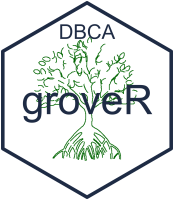
Purpose
Clouds are the bane of remote sensing studies. They obscure the reflectance values of the end members we are interested in and if not dealt with will skew results. When mosaicking multiple satellite scenes together, inevitably there will be the odd year when including some cloud or haze is unavoidable.
groveR has a two step process for dealing with
clouds:
- Digitised clouds are converted to masks with the appropriate extents
and pixel size for your data using
make_mask(). - Clouds are then accounted for in the correct annual mosaic using
cloud_mask()which encodes the spatial location so that they can either be omitted from the analysis entirely or form part of a fuzzy classification where a probable classification based on the prior year’s data is constructed.
Use the make_mask() function
The user first familiarises themselves with the original mosaics,
identifies cloud or smoke haze, digitises a polygon around them and
saves the result as a shapefile. The shapefile must have an attribute
column called “year” which is populated with the 4 digit year that the
cloud was observed in. One shapefile can contain the digitised
boundaries of all clouds identified through the entire time series of
mosaics. The test data includes an example located at
vectors/cloud_vectors.shp.
# The general form of the function is (NOTE the default parameters)
# make_mask(ivect, refimage, attribname = "year", loc ="raster_masks/cloud_masks")
# We only need to assign the first 2 parameters as the defaults are fine
ivect <- "vectors/cloud_vectors.shp"
refimage <- "veg_dens/lgcsmp_lsat_vdens_2011.tif"
# Run the function
make_mask(ivect, refimage)- ivect - input file path to cloud shapefile.
- refimage - file path to any raster that has been created during processing thus far. The format of the raster is used as a template to create the cloud masks.
What’s going to happen?
One cloud mask for each unique year found in the attribute column of
the cloud shapefile will be written to
raster_masks/cloud_masks/.
Use the cloud_mask() function
Next we apply the cloud masks we just made to the appropriate vegetation density annual rasters.
# The general form of the function is (NOTE the default parameters)
# cloud_mask(irast, imask, ext = ".tif")
# We only need to assign the first 2 parameters as the defaults are fine
irast <- "veg_dens_mskd"
imask <- "raster_masks/cloud_masks"
# Run the function
cloud_mask(irast, imask)- irast - input masked veg density rasters directory.
- imask - input cloud masks raster directory.